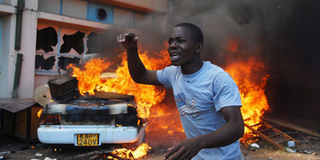Politicians, traders organised and financed killer gangs, says report

A scene of 2007/08 post-poll violence that formed the basis of The Hague trials starting Tuesday. Local investigators found out that suspected masterminds raised millions of shillings to fund killer gangs. Key politicians and businessmen are said to have supplied funds that were used to provide transport for the killers and purchase of food supplies for them. PHOTO|FILE.
What you need to know:
- The Justice Philip Waki-led Commission of Inquiry into Post Election Violence Commission said top politicians and businessmen held various meetings— some at night — to plan the orgy of violence that claimed the lives of 1,333 people.
Local investigators of the 2007/08 post-poll violence that formed the basis of The Hague trials starting Tuesday found out that suspected masterminds raised millions of shillings to fund killer gangs.
The Justice Philip Waki-led Commission of Inquiry into Post Election Violence Commission said top politicians and businessmen held various meetings— some at night — to plan the orgy of violence that claimed the lives of 1,333 people.
Although the violence was, in part, spontaneous as people reacted to the results of the bungled December 27 General Election, the commission said much of it was also well planned, funded and executed.
Key politicians and businessmen supplied funds that were used to provide transport for the killers and purchase of food supplies for them during the untoward activities.
The money was also used to buy weapons like machetes, arrows, and for procuring petroleum that was used to torch houses and buildings like was the case at Kiambaa Church in Eldoret on the eve of 2008 New Year celebrations.
From the report, descriptions show that at least six Cabinet ministers and five MPs, who served under the last Kibaki regime, businessmen and former lawmakers raised funds to finance militia activities.
Their names were believed to have been in the secret envelope that was handed over to former UN Secretary-General Kofi Annan who mediated peace talks between then President Kibaki’s PNU and then ODM leader Raila Odinga, who later became Prime Minister.
According to the report, a former minister from Rift Valley Province and a former minister from Nyanza were implicated in the violence. Others were prominent businessmen from Central and Rift Valley provinces. However, it is not clear who Justice Waki chose to include in his envelope. Mr Annan handed over the envelop to the International Criminal Court and was believed to have provided a pointer to the suspects of the on-going case.
Some Kenyans moved to court last week seeking to have the names that were in the envelope made public.
One of the prominent leaders is listed as having sponsored a gang of youths to attack rivals during campaigns. The same leader secured their freedom after they were arrested.
The other prominent politician is among leaders accused of sponsoring the Mungiki sect members to unleash terror in Nakuru and Naivasha.
He was among business people who held secret meetings to raise funds for revenge attacks against the Luo, Luhya and Kalenjin communities.
Others who helped him included two former Central Rift MPs and a prominent Nakuru businessman.
The decision to stuff the names in an envelope was taken to prevent the culprits from interfering with evidence ahead of the official investigations that were initially meant to be conducted by a quasi-international tribunal that would have been based in Kenya.
The Waki Commission said the pattern of the violence showed there was planning and organisation by politicians and businessmen, who enlisted criminal gangs to execute the mayhem.
In places such as Naivasha, Nakuru and slum areas of Nairobi, “Kikuyu gangs were mobilised and used to unleash violence against Luos, Luhyas and Kalenjins, “ and “to expel them from their rented residences,” says the report.
In turn, organised Kalenjin youths, particularly in the North Rift, attacked and drove out Kikuyus who lived there.
Pointers to the organisation by politicians and businessmen included warnings issued to the victims before the attacks were executed.
The violence also involved large numbers of attackers, who were “often mobilised from areas outside the location of violence”.
“Petrol and weapons were used in various places to carry out the attacks and destruction, which required arrangements as regards the acquisition, concealment and transport,” says the report.
A further pointer to the organised nature of the attacks was the fact that they targeted certain ethnic groups.
Politicians who contested the 2007 General Election were blamed for precipitating the violence by “conducting campaigns in a strident and confrontational manner”.
They cast the Majimbo (federalism) debate in an ethnically divisive manner and failed to create confidence among voters around the electoral process and institutions.
The violence in Naivasha between January 27 and 30 was pre-planned and executed by Mungiki members who received the support of political and business leaders, according to the report.
In a report dated January 8, 2008, the NSIS said some four senior Kalenjin personalities were funding ODM activists during the violence.




